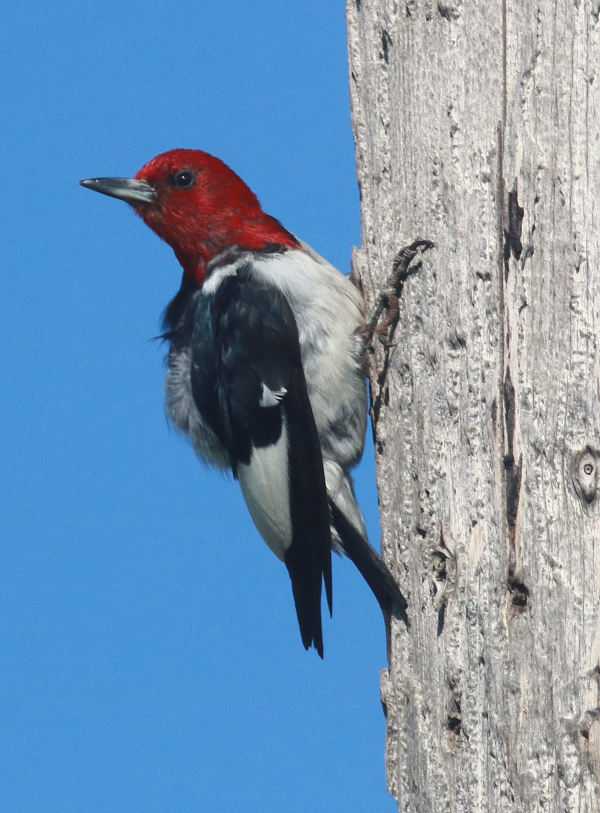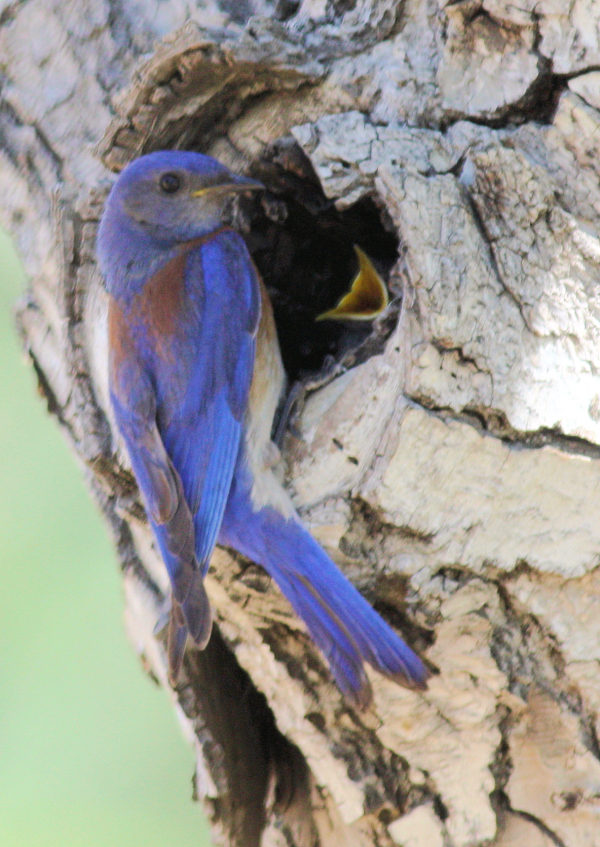
Dead trees, logs, and branches are valuable elements of bird habitats. Birds utilize nearly every part of a dead tree, log, or sizable branch to search for insects, larvae, and other foods in the bark and wood crevices, ranging from a host of warblers, orioles, nuthatches, creepers, woodpeckers, and more. A variety of woodpeckers and nuthatches excavate cavities in snags for nesting or roosting, and 88 species of cavity-nesting birds benefit from natural or woodpecker-excavated cavities.
While we may initially see a dead branch or tree as unsightly, we usually change our mind when we see attractive birds utilizing this important habitat element. That’s when we begin appreciating the importance of snags (dead trees and large branches) to birds and other animals. Of course, if a snag is a safety factor, that’s another story; but can you make the snag safe rather than removing it? Perhaps shortening the height of the dead tree, or trimming some of its branches will resolve any safety factors. Likewise, if you consider a dead tree as unsightly, consider removing unsightly portions of the snag — perhaps certain branches — and maybe the beautiful, interesting birds the snag attracts will outweigh its perceived unsightliness. Realistically, you can use a snag as a decorative element in your yard or garden, or fashion It into a distinctive conversation piece.
A snag is especially valuable if it already has a natural cavity, or crevice, or a broken top that some owls especially like to use as nest sites. But if the snag has no natural cavities or other features, never fear; invariably, one of the many woodpeckers that inhabit your area may find the dead wood especially attractive for excavating a cavity. During ensuing years, a woodpecker cavity can attract a series of cavity-nesting species that may include bluebirds, wrens, chickadees, nuthatches, titmice, and many more.
Even if a snag remains unused by nesting birds, it will attract a variety of birds that will use higher bare branches as look-out and hunting perches, including species of flycatchers, kingbirds, swallows, hawks, owls, and other birds, plus these branches provide a prominent perch for singing and territorial songbirds.
Plant a Snag?
In the absence of a dead tree, believe it or not, some advance backyard birders have “planted” or installed a snag (or two). This option even permits you to find the right snag that may already have a natural cavity or woodpecker-excavated cavity, and just the right look for your property. Keep in mind that a snag can actually be a decorative element you can add to your yard; it’s just a matter of finding one that you like and can appreciate as much as the birds will.
Paul Konrad, The Birding Wire’s Editor, shared a great story that may inspire you to better appreciate the power of snags. Paul wrote: "Friends in Illinois once 'planted' a snag in an open area of their yard — a dead tree trunk about a dozen feet tall, anchored into a hole in the ground, such as you might do for a large fencepost or power pole. In a surprisingly short time, about a week if I remember correctly, a pair of Red-headed Woodpeckers began excavating a cavity. How can you beat that?
"For a couple days the impressive woodpeckers worked on their new 'home,' and appeared to be ready to begin the nesting process, when the perfect snag scenario was thrown into turmoil by a pair of marauding European Starlings. A serious fight ensued for an extended period, and it turned out that the starlings took over the new nesting cavity. Very disappointed, but not beaten, my friends reacted by installing a second snag about 40 feet away from the first one and, sure enough, a pair of Red-headed Woodpeckers soon arrived (possibly the same pair) and began excavating a cavity in the second tree snag! My friends enjoyed the ensuing activities of the nesting period as the two species raised their respective broods, and they have annual accolades to share about the activities they view and photograph at their bird snags."
While Paul’s example is undoubtedly an extreme case of an almost instant utilization of a snag, it’s a super example of the potential of what can happen if you preserve an existing dead tree, relocate a snag, or “plant” a new one — one that you choose and approve of its look and its location. Overall, there is no limit to the potential fun and thrills that may result at the snag in your yard.
You can also refer to an interesting article about snags at http://content.yardmap.org/learn/habitat-feature-snags/.
Share your backyard birding experiences and photos at editorstbw2@gmail.com.









